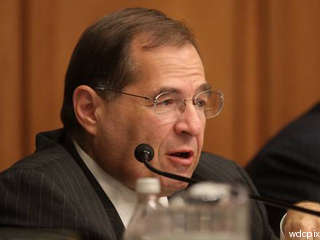Congress is joining U.S. DOT in committing more resources to a national freight plan, a more strategic way of moving goods than the current haphazard and fragmented current approach. As mandated by MAP-21, U.S. DOT is working on a strategic plan for a nationwide freight network, and last month, Congress kicked off its contribution, holding an inaugural hearing of the new, specially-appointed freight panel of the House Transportation Committee. At that first hearing, panel members heard from representatives of the trucking, freight rail, and shipping industries, as well as labor.

The Congressional panel on freight will be traveling the country over the next few months seeking input on the nationwide freight plan.
At the hearing, Jerrold Nadler (D-NY) emphasized the need to develop a 21st century freight transportation system in a way that doesn't prioritize highways over other modes.
"MAP-21 authorized some incentives to encourage states to develop highway freight plans... and required the Federal Highway Administration to designate a national freight network," Nadler said. "There remains much work to be done to expand this vision to include all modes of transportation -- highway, rail, water and air -- to ensure that the resources are available to implement this vision."
In the past, Obama administration officials have asserted some modal preferences in the "goods movement hierarchy." Deputy Secretary John Porcari said in 2010 that “we want to keep goods movement on water as long as possible, and then on rail as long as possible and truck it for the last miles.”
Each panel witness provided recommendations guided by his own industry's self-interest, and none offered a broad, multi-modal philosophy. There did seem to be general agreement on a few matters, primarily that the federal government has a role to play in funding major freight projects.
Fred Smith, president of FedEx, contended that regulations allowing bigger trucks would improve efficiency and environmental outcomes -- an argument refuted by opponents who point out that bigger, heavier trucks will require more road maintenance and pose a greater danger on the roads.
Smith, like nearly all the other panelists, argued for more revenue.
"We need a funding mechanism in the form of a revised fuel tax or vehicle mileage tax, which the user community almost universally supports to fund additional infrastructure, particularly in the more congested parts of the country," he said.
Wick Moorman, president and CEO of Norfolk Southern, complained about excessive government regulations limiting new investment in freight rail. "The longer it takes to steer through regulatory hurdles, the longer we wait for economic growth," he said, though he didn't cite specific regulatory obstacles.
Moorman didn't exactly plug increased mode share for freight rail, but trucking executive Derek Leathers didn't miss his chance to go to the mat for highways. He argued that lawmakers shouldn't shift resources away from highways, noting that trucking moves about 68 percent of all freight. "While we are bullish on the future of intermodal, claims that these changes will have significant impact on modal share, in my view, are overstated," he said.
Arguing that highway bottlenecks cost the trucking industry $19 billion a year, Leathers made it clear that his industry remains a big cheerleader for highway expansion. "We recommend much greater investment in the national highway system," he said. "The trucking industry is wholly dependent on federal and state and public agencies to spend the $33 billion in highway users' fees in a way that provides a good return on our investment."
While MAP-21 presents some opportunities to improve freight, Nadler said, it also increases obstacles to a high-functioning, well-integrated national freight system.
For one, MAP-21 provided only one year of dedicated funding for the Projects of National and Regional Significance program, established in 2005 under SAFETEA-LU as one of the few discretionary grant programs that can think outside state boundaries. Freight projects are top candidates for funds like PNRS and TIGER, a similar discretionary program that MAP-21 failed to authorize.
States are the only eligible beneficiaries of PNRS money -- to say nothing of the 92.6 percent of federal transportation funding that MAP-21 allocated to states by formula.
"Although this state-based system addresses state and local surface transportation projects well," Nadler said, "it is poorly suited to address critical national transportation projects, such as major freight projects that provide broadly dispersed benefits but high local costs."
At a Budget Committee hearing last week, Oregon Democrat Earl Blumenauer made a similar point. He challenged proponents of devolving federal authority to the states to show him studies proving that state and local governments were interested in planning and funding projects to improve national freight movement.
Furthermore, said Nadler, "MAP-21 did not address what are arguably the most challenging aspects of freight policy: what to pay for and how to do it." The same could be said of all aspects of transportation.
The panel will be traveling to Memphis, Louisville, Los Angeles, and New York to hear testimony in the coming months.





